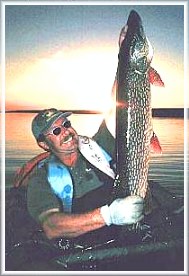Fly-fishing for Prairie Pike
Introduction
By Clive Schaupmeyer
This the first of a series of five articles about fly-fishing
for pike. The articles include: introduction; equipment and rigging; flies
and other gear; when and where; and techniques.
Pursuing plucky prairie pike with flies is a fly-fishing bonus. It is
a practical remedy–and blessing–for many of us who want to fly-fish often,
but do not live close to trout streams. Our prairie lakes and reservoirs
may not have the allure of mountain streams or pristine northern lakes,
and there may not be quite as many pike–or as many big pike–as up North.
But the waters are close, the action can be hot, and many prairie waters
contain trophy pike.
If you live anywhere in Canada where there are pike, and have yet to
try them with fly gear, you are in for a treat. They can be electrifying
on a fly rod, especially in the spring when their metabolism and fighting
spirit are at their peak. Or, if you've been thinking of flying to a northern
lodge for early season pike action, then wait no longer!
Pike readily take flies and are rough-and-tumble fighters. Battles are
usually down and dirty, and big fish can be difficult to land. They'll
make short line-hauling runs, often spinning a float-tube and angler. Seeking
refuge in deeper water or weed beds, pike pull doggedly and double over
the strongest of fly rods.

My passion for fly-fishing began years ago when I started chasing trout
in streams. But I live in Brooks, Alberta–a genuine prairie town–and it's
a two-to three-hour drive to my favorite mountain and foothills streams.
However, several reservoirs containing pike are within 20 minutes of town,
so friends and I can fly-fish after supper on warm spring evenings. Or,
we can do yard chores and attend to family duties on weekends, and still
get out fly-fishing for a few hours. Thus, we can be socially responsible
and fly-fish all we want.
A few days later I was standing in the bay casting gaudy flies to sex-crazed
pike. In the first two or three years a few pike were caught in that bay,
but the inlet has since grown in with cattails so they no longer spawn
there. I've also learned that trying to attract pike in the throes of courtship
is not as productive as waiting for the post-spawn action.
Each May and June, friends and I spend many days in our pontoon boats
or float tubes on local reservoirs catching lots of feisty two-to five-pound
pike. Six-to 10-pounders are not uncommon, and each year a few trophies
are caught. (These trophies are caught by my friends, as I seem to be forever
hexed against catching a real wall-hanger pike over 20 pounds.)
In addition to being closer to home, there are other practical reasons
to fly-fish for pike. The early season pike frenzy coincides with spring
runoff in many of our foothill and mountain trout streams; some trout streams
don't legally open for fishing until mid June; and pike waters are still
relatively uncrowded compared to many trout streams.
Pike (Esox lucius) are native to the northern hemisphere, ranging from
the northern United States through most of Canada and Alaska, Europe and
Asia. Pike live in lakes and in slow, meandering streams and rivers throughout
a large part of Canada, but not in Nova Scotia, PEI, Newfoundland and all
but northern British Columbia.
Pike in southern Alberta typically range from two to 10 pounds, with
the majority between two and five pounds. Females of 36 to 45 inches (or
more), weighing from 10 to 30 pounds, are occasionally brought to hand.
Ken Zorn, holds the local fly-fishing pike record at 43 inches. My personal
best is 38 inches.
I've fly-fished in northern Alberta where the average size of
pike is larger than our pike in the South, ranging from five to 10 pounds–the
majority being six to eight pounds–and many over 10 pounds. And more secluded
lakes in northern parts of the Prairie Provinces typically produce higher
numbers of trophy pike over 20 pounds. The record weight in Manitoba is
42 pounds, it's 43 pounds in Saskatchewan, and 38 pounds in Alberta. There
are some big pike out there, folks–and they eat big flies.
Pike are piscivorous (fish eating), aggressively attacking and consuming
any fish smaller than themselves, including other pike. Large streamers
that imitate the colour and action of resident baitfish will catch pike,
although it's not always clear what some pike flies are actually supposed
to represent. Possibly the gaudy flies imitate young whitefish, but more
likely pike attack because they are opportunistic feeders that can be lured
by anything flashy, or by anything that remotely resembles a meal. I've
caught 10-inch pike that attacked five-inch streamers. Not something I
like to talk about, but it illustrates how fierce these finny critters
can be no matter what their size. ~ Clive Schaupmeyer
Our Man In Canada Archives
|

 April 12th, 1999
April 12th, 1999


 April 12th, 1999
April 12th, 1999

